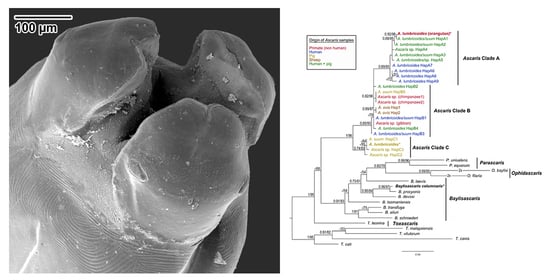First Study of Ascaris lumbricoides from the Semiwild Population of the Sumatran Orangutan Pongo abelii in the Context of Morphological Description and Molecular Phylogeny
Abstract
1. Introduction
| Species | Host | Material | Locality | References |
|---|---|---|---|---|
| A.lumbricoides | P. pygmaeus, captive | specimens | France Zoo | [27] |
| A.satyri | P. pygmaeus, captive | specimens | Museum Paris (imported from Borneo) | [28] |
| A.lumbricoides | P. pygmaeus, captive | specimens | Zoo Calcutta (India) | [29] |
| A.lumbricoides | P. pygmaeus, captive | specimens | Zoo Philadelphia (imported from Borneo) | [30] |
| A.lumbricoides | P. pygmaeus, captive | specimens | Zoo (Japan) | [31] |
| A.lumbricoides | P. pygmaeus, captive | specimens | Zoo London (UK) | [32,33] |
| A.lumbricoides | P. pygmaeus, captive | specimens | Zoo Amsterdam Rotterdam | [34] |
| Ascaris spp. | P. pygmaeus, captive | eggs | Primate Center Atlanta (USA) | [35] |
| Ascaris sp. | Pongo spp. captive, semi-wild | eggs | Zoo Jakarta, Sumatra-Bohorok, Kalimantan-Tanjung Puting (Indonesia) | [26] |
| A.lumbricoides | P. abelii, wild | Just simple list | Sumatra-Ketambe (Indonesia) | [36] |
| Ascaris sp. | P. pygmaeus, rehabilitant | eggs | Kalimantan-Tanjung Puting (Indonesia) | [24] |
| Ascaris sp. | P. pygmaeus, captive | eggs | Zoo Jakarta (Indonesia) | [24] |
| Ascaris sp. | P.abelii, rehabilitant | eggs | Sumatra-Bohorok (Indonesia) | [24] |
| “Ascarids” | Pongo spp. captive | eggs and specimens | from 50 international Zoo institutions | [37] |
| Ascaris sp. | P. abelii, wild | eggs | Sumatra-Ketambe (Indonesia) | [25] |
| A.lumbricoides | P. pygmaeus, during rehabilitation | eggs | Kalimantan-Tanjung Puting (Indonesia) | [21] |
| Ascaris sp. | P. pygmaeus, captive, semi-wild | eggs | Kalimantan-Wanariset (Indonesia) | [38] |
| A. lumbricoides | P. abelii, semi-wild | eggs | Sumatra-Bohorok (Indonesia) | [22] |
| A. lumbricoides | P. pygmaeus, captive | eggs | Zoo Wroclaw (Poland) | [39] |
| Ascaris sp. | P. abelii, captive | eggs | Sumatra (Indonesia) | [8] |
| Ascaris sp. | P. abelii, captive | eggs | Sumatra-quarantine Batu Mbelin (Indonesia) | [40] |
| Ascaris sp. | Pongo spp., captive | eggs | Zoo Rizal (Philippines) | [41] |
| Ascaris sp. | P. pygmaeus, captive | eggs | Kalimantan-Nyaru Menteng, Wanariset (Indonesia) | [7] |
| A. lumbricoides | P. pygmaeus, wild | eggs | Kalimantan-Sebangau (Indonesia) | [23] |
| Ascaris spp. | P. pygmaeus, wild, urban, captive | eggs | Peninsular Malaysia and Malaysian Borneo (Sabah and Sarawak) | [10] |
| Ascaris sp. | P. pygmaeus, captive | eggs | Matang Wildlife Centre, Kuching Division, Sarawak (Malaysia) | [9] |
2. Methods
2.1. Sample Collection
2.2. Morphological Analyses
2.3. DNA Extraction, PCR Amplification, and Gene Characterisation
2.4. Sequence Alignment and Phylogenetic Analyses
2.5. Ethical Note
3. Results
3.1. Morphological Analysis
3.2. Molecular-Genetic Analysis
Characterisation of 18S rDNA Region
3.3. Characterisation of ITS Region
3.4. Characterisation of CO1 mtDNA Region
3.5. Phylogenetic Analyses
4. Discussion
Author Contributions
Funding
Institutional Review Board Statement
Informed Consent Statement
Data Availability Statement
Acknowledgments
Conflicts of Interest
References
- Brandon-Jones, D.; Eudey, A.A.; Geissmann, T.; Groves, C.P.; Melnick, D.J.; Morales, J.C.; Shekelle, M.; Stewart, C.B. Asian primate classification. Int. J. Primatol. 2004, 25, 97–164. [Google Scholar] [CrossRef]
- IUCN. IUCN Red List of Threatened Species. Version 2022.2. 2022. Available online: www.iucnredlist.org (accessed on 16 February 2023).
- Foitová, I.; Huffman, M.A.; Nurcahyo, W.; Olšanský, M. Parasites and their impacts on orangutan health. In Orangutans–Geographic Variation in Behavioral Ecology and Conservation, 1st ed.; Wish, S.A., Suci, S.U., Setia, T.M., van Schaik, C.P., Eds.; Oxford University Press: New York, NY, USA, 2009; pp. 157–169. [Google Scholar]
- Nurcahyo, W.; Konstanzová, V.; Foitová, I. Parasites of orangutans (primates: Ponginae): An overview. Am. J. Primatol. 2017, 79, e22650. [Google Scholar] [CrossRef] [PubMed]
- Foitová, I.; Baruš, V.; Hodová, I.; Koubková, B.; Nurcahyo, W. Two remarkable pinworms (Nematoda: Enterobiinae) parasitizing orangutan (Pongo abelii) in the Sumatra (Indonesia) including Lemuricola pongoi n. sp. Helminthologia 2008, 45, 162–168. [Google Scholar] [CrossRef]
- Foitová, I.; Baruš, V.; Koubková, B.; Mašová, Š.; Nurcahyo, W. Description of Lemuricola (Lemuricola) pongoi—Male (Nematoda: Enterobiinae) parasitising orangutan Pongo abelii. Parasitol. Res. 2010, 106, 817–820. [Google Scholar] [CrossRef] [PubMed]
- Labes, E.M.; Hegglin, D.; Grimm, F.; Nurcahyo, W.; Harrison, M.E.; Bastian, M.L.; Deplazes, P. Intestinal parasites of endangered orangutans (Pongo pygmaeus) in East Kalimantan, Borneo, Indonesia. Parasitology 2010, 137, 123–135. [Google Scholar] [CrossRef]
- Mul, I.F.; Paembonan, W.; Singleton, I.; Wich, S.A.; van Bolhuis, H.G. Intestinal parasites of free-ranging, semicaptive and captive Pongo abelii in Sumatra, Indonesia. Int. J. Primatol. 2007, 28, 407–420. [Google Scholar] [CrossRef]
- Teo, S.Z.; Tuen, A.A.; Madinah, A.; Aban, S.; Chong, Y.L. Occurrence of gastrointestinal nematodes in captive non-human primates at Matang Wildlife Centre, Sarawak. Trop. Biomed. 2019, 36, 594–603. [Google Scholar]
- Adrus, M.; Zainudin, R.; Ahamad, M.; Jayasilan, M.A.; Abdullah, M.T. Gastrointestinal parasites of zoonotic importance observed in the wild, urban, and captive populations of non-human primates in Malaysia. J. Med. Primatol. 2019, 48, 22–31. [Google Scholar] [CrossRef] [PubMed]
- Drakulovski, P.; Bertout, S.; Locatelli, S.; Butel, C.; Pion, S.; Mpoudi-Ngole, E.; Delaporte, E.; Peeters, M.; Mallié, M. Assessment of gastrointestinal parasites in wild chimpanzees (Pan troglodytes troglodytes) in southeast Cameroon. Parasitol. Res. 2014, 113, 2541–2550. [Google Scholar] [CrossRef]
- Kalema-Zilusoka, G.; Rothman, J.M.; Fox, M.T. Intestinal parasites and bacteria of mountain gorillas (Gorilla beringei beringei) in Bwindi Impenetrable National Park, Uganda. Primates 2005, 46, 59–63. [Google Scholar] [CrossRef]
- Mafuyai, H.B.; Barshep, Y.; Audu, B.S.; Kumbak, D.; Ojobe, T.O. Baboons as potential reservoirs of zoonotic gastrointestinal parasite infections at Yankari National Park, Nigeria. Afr. Health Sci. 2013, 13, 252–254. [Google Scholar] [CrossRef] [PubMed]
- Xie, Y.; Niu, L.; Zhao, B.; Wang, Q.; Nong, X.; Chen, L.; Zhou, X.; Gu, X.; Wang, S.; Peng, X.; et al. Complete mitochondrial genomes of chimpanzee- and gibbon-derived Ascaris isolated from a zoological garden in Southwest China. PLoS ONE 2013, 8, e82795. [Google Scholar] [CrossRef] [PubMed]
- von Linstow, O. Compendium der Helminthologie; Nachtrag: Die Litteratur der Jahre 1878–1889; Hahnsche Buchhandlung: Hannover, Germany, 1889; p. 151. [Google Scholar]
- Mozgovoy, A.A. Fundamentals of Nematodology. In Volume 1, Ascaridata of Animals and Man and the Diseases They Caused by Them, 1st ed.; Publication House Akademii Nauk SSSR: Moscow, Russia, 1953; p. 616. [Google Scholar]
- Skryabin, K.I.; Shikhobalova, N.P.; Mozgovoy, A.A. Key to Parasitic Nematodes Volume II: Oxyurata and Ascaridata, 1st ed.; Akademiya Nauk SSSR Publishers: Moscow, Russia, 1951; p. 631. [Google Scholar]
- Yamaguti, S. Systema Helminthum III: The Nematodes of Vertebrates (Part 1 and 2), 1st ed.; Interscience Publishers: New York, NY, USA, 1961; p. 1261. [Google Scholar]
- Sprent, J.F.A. Notes on Ascaris and Toxascaris with a definition of Baylisascaris gen. nov. Parasitology 1968, 58, 185–198. [Google Scholar] [CrossRef] [PubMed]
- Kirby, M.D.; Podani, J.M.; Shaw, J.H.; Edwards, S.J.; Rayburn, J.D.; Hood, M.W. Supplement 19, Part 4, Parasite-Subject Catalogue: Parasites: Nematoda and Acanthocephala; United States Government Printing Office: Washington, DC, USA, 1975. [Google Scholar]
- Djojoasmoro, R.; Purnomo, A. Prevalensi Nematoda Usus pada Orangutan di Taman Nasional Tanjung Puting Kalimantan Tengah. J. Primatol. Indones. 1998, 2, 9–12. [Google Scholar]
- Foitová, I. Parasites in Orangutans (Pongo pygmaeus Linnaeus, 1760) with Connection to the Ecology and Ethology Factors. Ph.D. Thesis, Veterinary and Pharmaceutical University Brno, Brno, Czech Republic, 2002. [Google Scholar]
- Hilser, H.B.; Cheyne, S.M.; Ehlers-Smith, D.A. Socioecology and gastro-intestinal parasites of sympatric primate species inhabiting the Sabangau peat-swamp forest, Central Kalimantan. Am. J. Primatol. 2011, 74, 31–49. [Google Scholar]
- Collet, J.; Galdikas, B.M.F.; Sugarjito, J.; Jojosudharmo, S. A coprological study of parasitism in orangutans (Pongo pygmaeus) in Indonesia. J. Med. Primatol. 1986, 15, 121–129. [Google Scholar] [CrossRef]
- Djojosudharmo, S.; Gibson, A.T. Parasit intestinalis pada primata liar di Taman Nasional Gunung Leuser, Sumatra. In Proceedings of the Simposium and Seminar Nasional Primata, Bandung, Indonesia, 13–14 October 1993; pp. 13–14. [Google Scholar]
- Stafford, E.E.; Moede, A.L.; Brown, R.J.; Galdikas-Brindamour, B. Enteric parasites of orangutans (Pongo pygmaeus) in Indonesia; Special Report; Naval Aerospace Medical Research Laboratory: Pensacola, FL, USA, 1978. [Google Scholar]
- Blanchard, E. Recherches sur l’Organisation des Vers. In Annales des Sciences Naturelles, 3rd ed.; Place de l’Ecole de Médecine: Paris, France, 1848; pp. 106–202. [Google Scholar]
- Chatin, J.M. Étude anatomique et zoologique de l’ascaride de l’Orang-outang. Comptes Rendus Soc. Biol. 1877, 26, 384–387. [Google Scholar]
- Baylis, H.A.; Daubney, M. Report of the parasitic nematodes in the collection of the Zoological Survey of India. Mem. Indian Mus. Calcutta 1922, 7, 263–347. [Google Scholar] [CrossRef]
- Canavan, W.P.N. Nematode parasites of vertebrates in the Philadelphia Zoological Garden and vicinity. Parasitology 1931, 23, 196–229. [Google Scholar] [CrossRef]
- Matsubayashi, H. On Ascaris and Trichuris found in orangutans with some remarks on specific characters on Trichuris. Keio Igaku 1934, 14, 965–976. [Google Scholar]
- Sandosham, A.A. On Enterobius vermicularis (Linnaeus, 1758) and some related species from primates and rodents. J. Helminthol. 1950, 24, 171–204. [Google Scholar] [CrossRef]
- Sandosham, A.A. On two helminthes from the orang utan, Leipertrema rewelli n.g., n.sp. and Dirofilaria immitis (Leidy, 1856). J. Helminthol. 1951, 25, 19–26. [Google Scholar] [CrossRef]
- Swierstra, D.; Jansen, J.; Van Den Broek, E. Parasites of zoo–animals in the Netherlands. Tijdschr. Diergeneesk 1959, 84, 1301–1305. [Google Scholar]
- Cummins, L.B.; Keeling, M.E.; McClure, H.M. Preventive medicine in anthropoids: Parasite control. Lab. Anim. Sci. 1973, 23, 819–821. [Google Scholar]
- Rijksen, H.D. A Field Study in Sumatran Orangutans (Pongo pygmaeus abelii Lesson 1827): Ecology, Behaviour and Conservation, 1st ed.; Veenman & B.V. Zonen: Wageningen, The Netherlands, 1978; pp. 1–416. [Google Scholar]
- Frazier-Taylor, H.; Galdikas, B.; Karesh, W.B. A Survey of Intestinal Parasites in Wild, Ex-Captive and Captive Orangutans (Pongo pygmaeus): An American Association of ZOO Keepers Research Project–Part One; Animal Keepers Forum 8: Seattle, WA, USA, 1987; pp. 245–254. [Google Scholar]
- Warren, K.S. Orangutan Conservation-Epidemiological Aspects of Health Management and Population Genetics. Ph.D. Thesis, Murdoch University, Murdoch, Australia, 2001. [Google Scholar]
- Okulewicz, A.; Lonc, E.; Borgesteede, F.H.M. Ascarid nematodes in domestic and wild terrestrial mammals. Pol. J. Vet. Sci. 2002, 5, 277–281. [Google Scholar]
- Wahyudi, R.; Singleton, I.; Saraswati, Y. Medical record in Sumatran orangutan quarantine Batu Mbelin–Sibolangit Medan North Sumatra. In Proceeding of the 3rd Meeting of the Asian Zoo Wildlife Medicine and Conservation, Bogor, Indonesia, 19–22 August 2008. [Google Scholar]
- Velasco, N.J.; Claveria, F.G. Intestinal parasites identified in caged orangutans (Pongo spp.) at the Avilon Zoo, Montalban Zoological Park, Rizal, Philippines. J. Protozool. Res. 2009, 19, 12–15. [Google Scholar]
- Joyce, S.A.; Reid, A.; Driver, F.; Curran, J. Application of polymerase chain reaction (PCR) methods to identification of entomo-pathogenic nematodes. In COST 812 Biotechnology: Genetics of Entomopathogenic Nematode-Bacterium Complexes; Burnell, A.M., Ehlers, R.U., Masson, J.P., Eds.; Proceedings Symposium Workshop, St. Patrick’s College, Maynooth, Ireland, DG XII; European Commission: Luxembourg, 1994; pp. 178–187. [Google Scholar]
- Vrain, T.C.; Wakarchuk, D.A.; Levesque, A.C.; Hamilton, R.I. Intraspecific rDNA restriction fragment length polymorphism in the Xiphinema americanum group. Fundam. Appl. Nematol. 1992, 15, 563–573. [Google Scholar]
- Floyd, R.M.A.; Rogers, D.; Lambshead, J.D.; Smith, C.R. Nematodes specific PCR primers for the 18S small subunit rRNA gene. Mol. Ecol. Notes 2005, 5, 611–612. [Google Scholar] [CrossRef]
- Das, K.; Chowdhury, P.; Ganguly, S. Internal Transcribed Spacer 1 (ITS1) based sequence typing reveals phylogenetically distinct Ascaris population. Comp. Struct. Biotechnol. J. 2015, 13, 478–483. [Google Scholar] [CrossRef]
- Nakano, T.; Okamoto, M.; Ikeda, Y.; Hasegawa, H. Mitochondrial cytochrome c oxidase subunit 1 gene and nuclear rDNA regions of Enterobius vermicularis parasitic in captive chimpanzees with special reference to its relationship with pinworms in humans. Parasitol. Res. 2006, 100, 51–57. [Google Scholar] [CrossRef]
- Grehan, J.R.; Schwartz, J.H. Evolution of the second orangutan: Phylogeny and biogeography of hominid origins. J. Biogeogr. 2009, 36, 1823–1844. [Google Scholar] [CrossRef]
- Betson, M.; Nejsum, P.; Bendall, R.P.; Deb, R.M.; Stothard, J.R. Molecular epidemiology of ascariasis: A global perspective on the transmission dynamics of Ascaris in people and pigs. J. Infect. Dis. 2014, 210, 932–941. [Google Scholar] [CrossRef] [PubMed]
- Cavallero, S.; Snabel, V.; Pacella, F.; Perrone, V.; D’Amelio, S. Phylogeographical studies of Ascaris spp. based on ribosomal and mitochondrial DNA sequences. PLoS Neglect. Trop. Dis. 2013, 7, e2170. [Google Scholar] [CrossRef] [PubMed]
- Jesudoss Chelladurai, J.; Murphy, K.; Snobl, T.; Bader, C.; West, C.; Thompson, K.; Brewer, M.T. Molecular epidemiology of Ascaris infecting pigs in Iowa. J. Infect. Dis. 2016, 215, 131–138. [Google Scholar] [CrossRef] [PubMed]
- Sadaow, L.; Sanpool, O.; Phosuk, I.; Rodpai, R.; Thanchomnang, T.; Wijit, A.; Anamnart, W.; Laymanivong, S.; Aung, W.P.P.; Janwan, P.; et al. Molecular identification of Ascaris lumbricoides and Ascaris suum recovered from humans and pigs in Thailand, Lao PDR, and Myanmar. Parasitol. Res. 2018, 117, 2427–2436. [Google Scholar] [CrossRef]
- Betson, M.; Halstead, F.D.; Nejsum, P.; Imison, E.; Khamis, I.S.; Sousa–Figueiredo, J.C.; Rollinson, D.; Stothard, J.R. A molecular epidemiological investigation of Ascaris on Unguja, Zanzibar using isoenzyme analysis, DNA barcoding and microsatellite DNA profiling. Trans. R. Soc. Trop. Med. Hyg. 2011, 105, 370–379. [Google Scholar] [CrossRef]
- Cavallero, S.; Rondón, S.; Monterrosa, I.A.; Šnábel, V.; Papajová, I.; Goldová, M.; Štrkolcová, D.; Caraballo, L.; Acevedo, N.; D’Amelio, S. Genotyping of Ascaris spp. infecting humans and pigs in Italy, Slovakia and Colombia. Infect. Genet. Evol. 2021, 94, 104997. [Google Scholar] [CrossRef]
- Katoh, K.; Misawa, K.; Kuma, K.I.; Miyata, T. MAFFT: A novel method for rapid multiple sequence alignment based on fast Fourier transform. Nucleic Acids Res. 2002, 30, 3059–3066. [Google Scholar] [CrossRef]
- Katoh, K.; Rozewicki, J.; Yamada, K.D. MAFFT online service: Multiple sequence alignment, interactive sequence choice and visualization. Brief. Bioinform. 2019, 20, 1160–1166. [Google Scholar] [CrossRef]
- Hall, T.A. BioEdit: A user-friendly biological sequence alignment editor and analysis program for Windows 95/98/NT. Nucleic Acids Symp. Ser. 1999, 41, 95–98. [Google Scholar]
- Tamura, K.; Stecher, G.; Kumar, S. MEGA11: Molecular Evolutionary Genetics Analysis Version 11. Mol. Biol. Evol. 2021, 38, 3022–3027. [Google Scholar] [CrossRef] [PubMed]
- Castresana, J. Selection of Conserved Blocks from Multiple Alignments for Their Use in Phylogenetic Analysis. Mol. Biol. Evol. 2000, 17, 540–552. [Google Scholar] [CrossRef] [PubMed]
- Kalyaanamoorthy, S.; Minh, B.Q.; Wong, T.K.; Von Haeseler, A.; Jermiin, L.S. ModelFinder: Fast model selection for accurate phylogenetic estimates. Nat. Methods 2017, 14, 587–589. [Google Scholar] [CrossRef] [PubMed]
- Ronquist, F.; Teslenko, M.; Van Der Mark, P.; Ayres, D.L.; Darling, A.; Höhna, S.; Larget, B.; Liu, L.; Suchrd, M.A.; Huelsenbeck, J.P. MrBayes 3.2: Efficient Bayesian phylogenetic inference and model choice across a large model space. Syst. Biol. 2012, 61, 539–542. [Google Scholar] [CrossRef] [PubMed]
- Nguyen, L.T.; Schmidt, H.A.; Von Haeseler, A.; Minh, B.Q. IQ-TREE: A fast and effective stochastic algorithm for estimating maximum-likelihood phylogenies. Mol. Biol. Evol. 2015, 32, 268–274. [Google Scholar] [CrossRef] [PubMed]
- Hoang, D.T.; Chernomor, O.; Von Haeseler, A.; Minh, B.Q.; Vinh, L.S. UFBoot2: Improving the ultrafast bootstrap approximation. Mol. Biol. Evol. 2018, 35, 518–522. [Google Scholar] [CrossRef]
- Rambaut, A. FigTree-Version 1.4. 3, A Graphical Viewer of Phylogenetic Trees. Computer Program Distributed by the Author. Available online: http://tree.bio.ed.ac.uk/software/figtree (accessed on 25 October 2017).
- Peng, W.; Yuan, K.; Zhou, X.; Hu, M.; Abs EL-Osta, Y.G.; Gasser, R.B. Molecular epidemiological investigation of Ascaris genotypes in China based on single-strand conformation polymorphism analysis of ribosomal DNA. Electrophoresis 2003, 24, 2308–2315. [Google Scholar] [CrossRef]
- Leles, D.; Araújo, A.; Vicente, A.C.P.; Iñiguez, A.M. ITS1 intra-individual variability of Ascaris isolates from Brazil. Parasitol. Int. 2010, 59, 93–96. [Google Scholar] [CrossRef]
- Nejsum, P.; Hawash, M.B.F.; Betson, M.; Stothard, J.R.; Gasser, R.B.; Andersen, L.O. Ascaris phylogeny based on multiple whole mtDNA genomes. Infect. Genet. Evol. 2017, 48, 4–9. [Google Scholar] [CrossRef]
- Šnábel, V.; Taira, K.; Cavallero, S.; D’Amelio, S.; Rudohradská, P.; Saitoh, Y. Genetic structure of Ascaris roundworm in Japan and patterns of its geographical variation. JPN J. Infect. Dis. 2012, 65, 179–183. [Google Scholar] [CrossRef]
- Cromton, D.W.T. Ascaris and ascariasis. Adv. Parasitol. 2001, 48, 285–375. [Google Scholar]
- Hartwich, G. Die Tierwelt Deutschlands. 62. In Teil, I. Rhabditida und Ascaridida; VEB Gustav Fischer Verlag: Jena, Germany, 1975; p. 256. [Google Scholar]
- Mozgovoy, A.A.; Popova, T.I.; Shalaeva, N.M.; Smitova, G.Y. The validity of some species of Ascaridata of man and animals. Trudy GELAN 1960, 10, 153–165. [Google Scholar]
- Mozgovoy, A.A. Helminths Domestic and Wild Suidae and Diseases Caused by Them, 1st ed.; Publication House Nauka: Moscow, Russia, 1967; p. 540. [Google Scholar]
- Arizono, N.; Yoshimura, Y.; Tohzaka, N.; Yamaga, M.; Tegoshi, T.; Onishi, K.; Uchikawa, R. Ascariasis in Japan: Is pig–derived ascaris infecting humans? JPN J. Infect. Dis. 2010, 63, 447–448. [Google Scholar] [CrossRef] [PubMed]
- Dold, C.; Holland, C.V. Ascaris and ascariasis. Microbes Infect. 2011, 13, 632–637. [Google Scholar] [CrossRef]
- Lamson, P.D.; Ward, C.B. Earth Worms as Test Objects for Determining the Value of Drugs to Be Used in Human Intestinal Helminth Infestations. Science 1936, 84, 293–294. [Google Scholar] [CrossRef]
- Abdulrachman, S.; Lie, K.J. Morphometrical differences between Ascaris from man and pigs. Doc. Med. Geogr. Trop. 1954, 6, 342–344. [Google Scholar]
- Madden, P.A.; Tromba, F.G.; Vetterling, J.M. En face views of Ascaris suum with the scanning electron microscope. J. Parasitol. 1970, 56, 202–203. [Google Scholar] [CrossRef]
- Sprent, J.F.A. Anatomical distinction between human and pig strains of Ascaris. Nature 1952, 170, 627–628. [Google Scholar] [CrossRef]
- Ubelaker, J.E.; Allison, V.F. Scanning electron microscopy of denticles and eggs of Ascaris lumbricoides and Ascaris suum. In Proceedings of the 30th Annual Proceeding Electron Microscopy Society of America, Los Angeles, CA, USA, 14 August 1972; pp. 1–2. [Google Scholar]
- Barry, J.M.; O’Rourke, F.J. Ascariasis in pig and man. Sci. Proc. R. Dublin Soc. (Ser. A) 1967, 3, 39–55. [Google Scholar]
- Borkovcová, M. Scanning electron microscopy of denticles of Ascaris lumbricoides Linné, 1758. Acta Univ. Agric. Silvic. Mendel. Brun. 1992, 3, 245–261. [Google Scholar]
- Lýsek, H. Contribution to the morphological problem of differences between Ascaris lumbricoides Linné 1758 and Ascaris suum Goeze 1782. Acta Soc. Zool. Bohemoslov. 1963, 27, 97–101. [Google Scholar]
- Prokopič, J. Scanning electron microscopic study of the morphology of Ascaris suum Goeze, 1782. Folia Parasitol. 1979, 2, 377–380. [Google Scholar]
- Schneider, A. Monographie der Nematoden, 1st ed.; Reimer: Berlin, Germany, 1866; p. 357. [Google Scholar]
- Uni, S.; Takada, S. Comparison of Scanning Electron Microscopy on Baylisascaris transfuga, Toxascaris leonina and Ascaris lumbricoides (Nematoda: Ascarididae). JPN J. Parasitol. 1981, 30, 187–195. [Google Scholar]
- Nadler, S.A. Phylogeny of some ascaridoid nematodes, inferred from comparison of 18S and 28S rRNA sequences. Mol. Biol. Evol. 1992, 9, 932–944. [Google Scholar]
- Nejsum, P.; Bertelsen, M.F.; Betson, M.; Stothard, J.R.; Murrell, K.D. Molecular evidence for sustained transmission of zoonotic Ascaris suum among zoo chimpanzees (Pan troglodytes). Vet. Parasitol. 2010, 17, 273–276. [Google Scholar] [CrossRef]
- Zhou, C.; Guo, T.; Deng, Y.; He, J.; Ouyang, S.; Wu, X. Mitochondrial phylogenomics of human-type Ascaris, pig-type Ascaris, and hybrid Ascaris populations. Vet. Parasitol. 2020, 287, 109256. [Google Scholar] [CrossRef]
- Li, Y.; Niu, L.; Wang, Q.; Zhang, Z.; Chen, Z.; Gu, X.; Xie, Y.; Yan, N.; Wang, S.; Peng, X.; et al. Molecular characterization and phylogenetic analysis of ascarid nematodes from twenty-one species of captive wild mammals based on mitochondrial and nuclear sequences. Parasitology 2012, 139, 1329–1338. [Google Scholar] [CrossRef]
- Blaxter, M.L.; Ley, P.D.; Garey, J.R.; Liu, L.Y.; Scheldeman, P.; Vierstraete, A.; Vanfleteren, J.R.; Mackey, L.Y.; Dorris, M.; Frisse, L.M.; et al. A molecular evolutionary framework for the phylum Nematoda. Nature 1998, 392, 71–75. [Google Scholar] [CrossRef]
- Zhu, X.; Chilton, N.B.; Jacobs, D.E.; Boes, J.; Gasser, R.B. Characterisation of Ascaris from human and pighosts by nuclear ribosomal DNA sequences. Int. J. Parasit. 1999, 29, 469–478. [Google Scholar] [CrossRef]
- Liu, G.H.; Wu, C.H.Y.; Song, H.Q.; Wei, S.J.; Xu, M.J.; Lin, R.Q.; Zhao, G.H.; Huang, S.Y.; Zhu, Y.Q. Comparative analyses of the complete mitochondrial genomes of Ascaris lumbicoides and Ascaris suum from humans and pigs. Gene 2012, 492, 110–116. [Google Scholar] [CrossRef]
- Eamsobhana, P.; Yong, H.S.; Boonyong, S.; Wanachiwanawin, D.; Tungtrongchitr, A. Genetic diversity and identity of Ascaris worms from human and pig hosts in Thailand. Vet. Parasitol. Reg. Stud. Rep. 2022, 33, 100752. [Google Scholar] [CrossRef] [PubMed]
- Hong, J.H.; Oh, C.S.; Seo, M.; Chai, J.Y.; Shin, D.H. Ancient Ascaris DNA sequences of cytochrome B, cytochrome C oxidase subunit 1, NADH dehydrogenase subunit 1, and internal transcribed spacer 1 genes from Korean Joseon mummy feces. J. Parasitol. 2017, 103, 795–800. [Google Scholar] [CrossRef] [PubMed]
- Sato, M.; Funayama, K.; Hoshi, R.; Takatsuka, H.; Sato, M.O. Ascaris lumbricoides found in ashore corpses from Korean peninsula to Japan. Parasitol. Int. 2019, 70, 1–4. [Google Scholar] [CrossRef] [PubMed]
- Leles, D.; Gardner, S.L.; Reinhard, K.; Iñigues, A.; Araujo, A. Are Ascaris lumbricoides and Ascaris suum a single species? Parasites Vectors 2012, 5, 1–7. [Google Scholar] [CrossRef] [PubMed]
- Criscione, C.D.; Anderson, J.D.; Sudimack, D.; Peng, W.; Jha, B.; Williams-Blangero, S.; Anderson, T.J. Disentangling hybridization and host colonization in parasitic roundworms of humans and pigs. Proc. R. Soc. B Biol. Sci. 2007, 274, 2669–2677. [Google Scholar] [CrossRef]
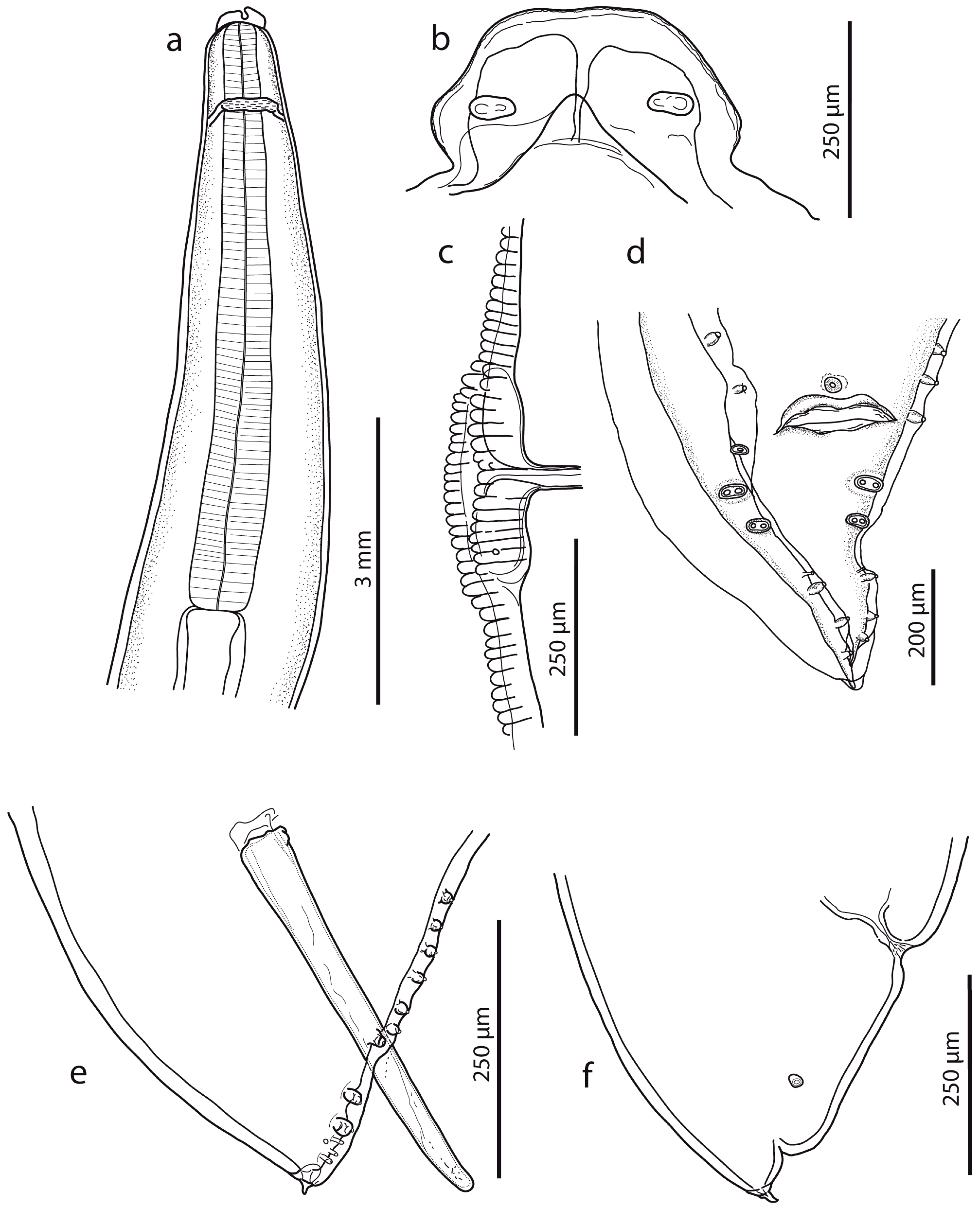
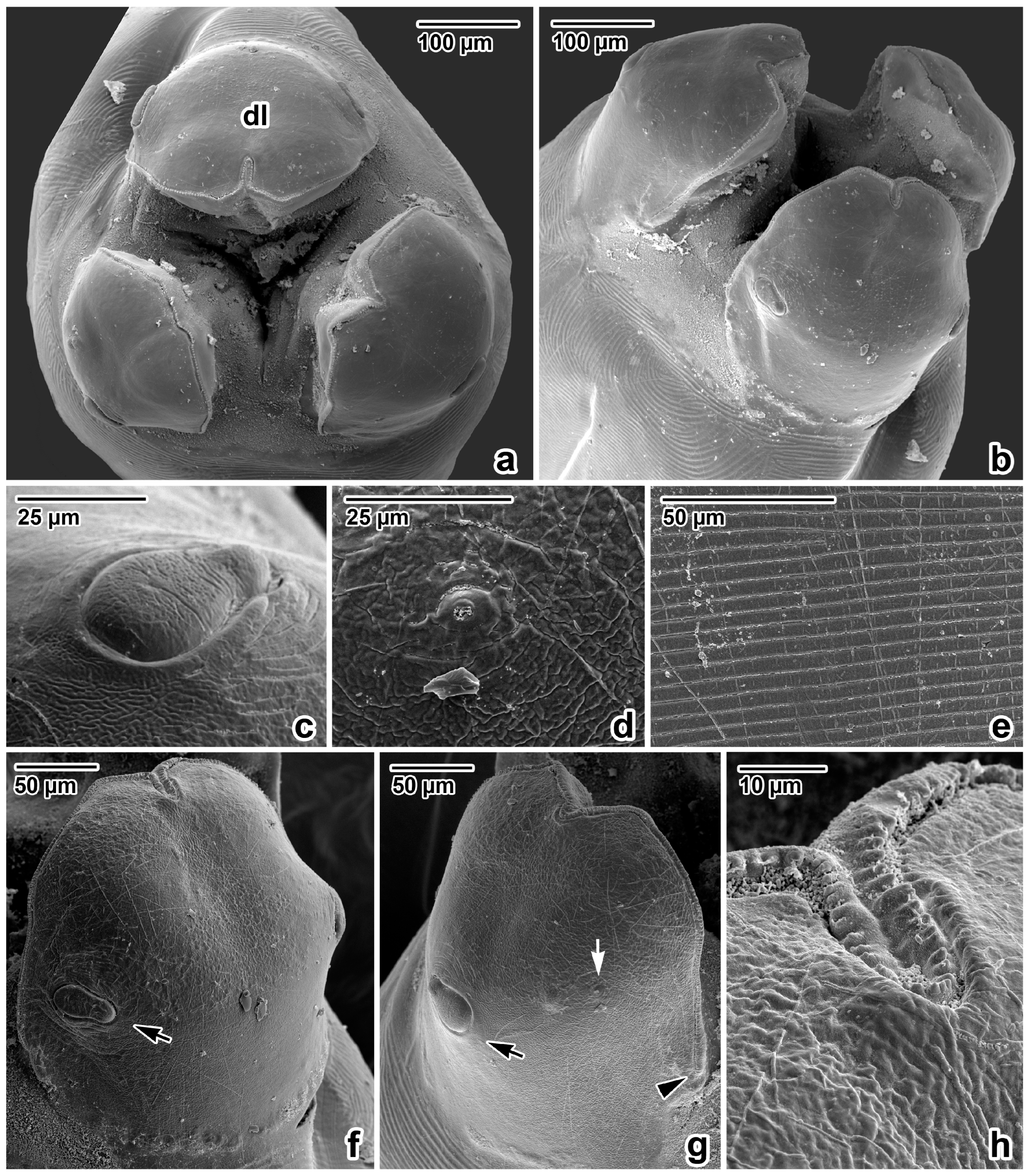
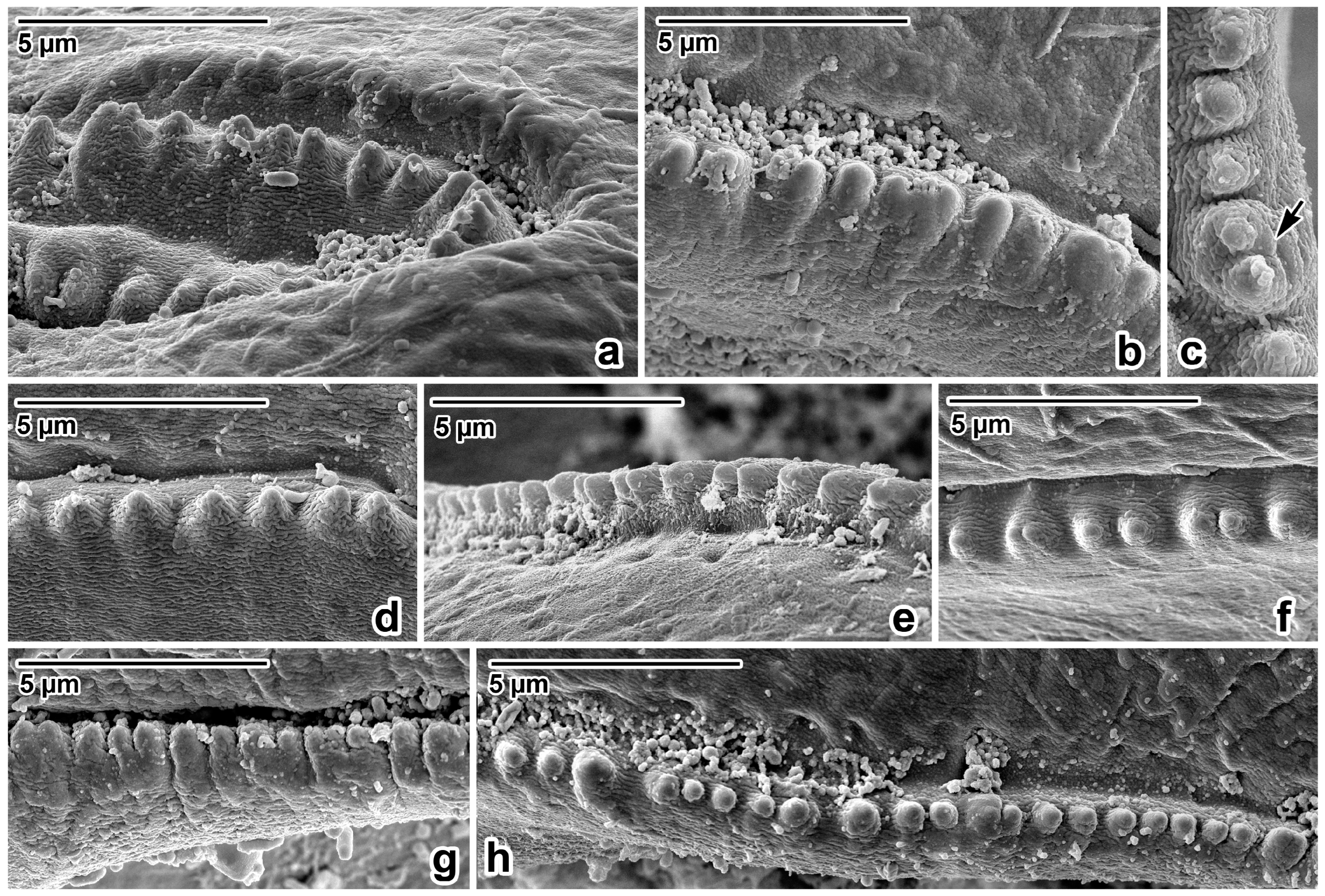
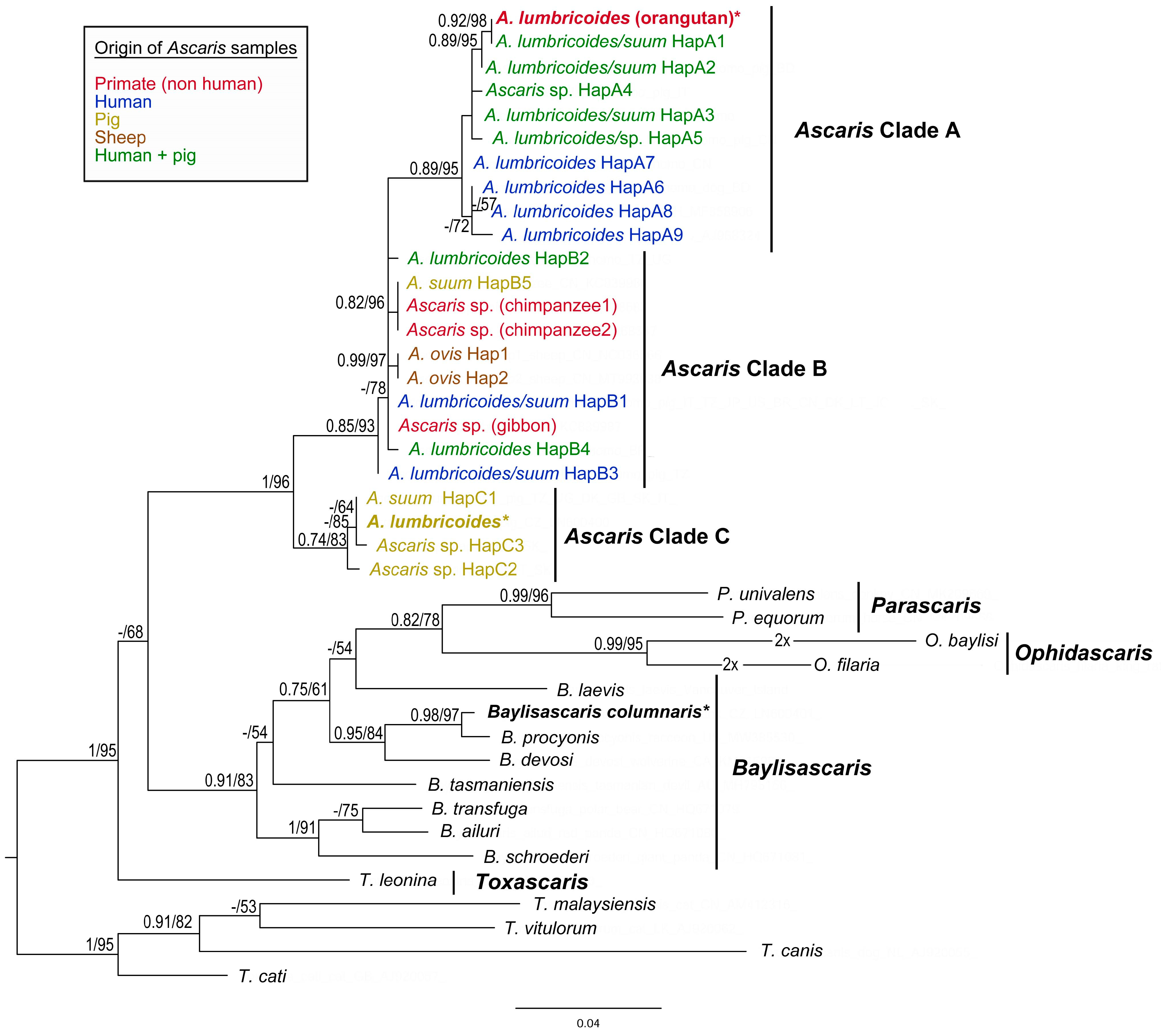
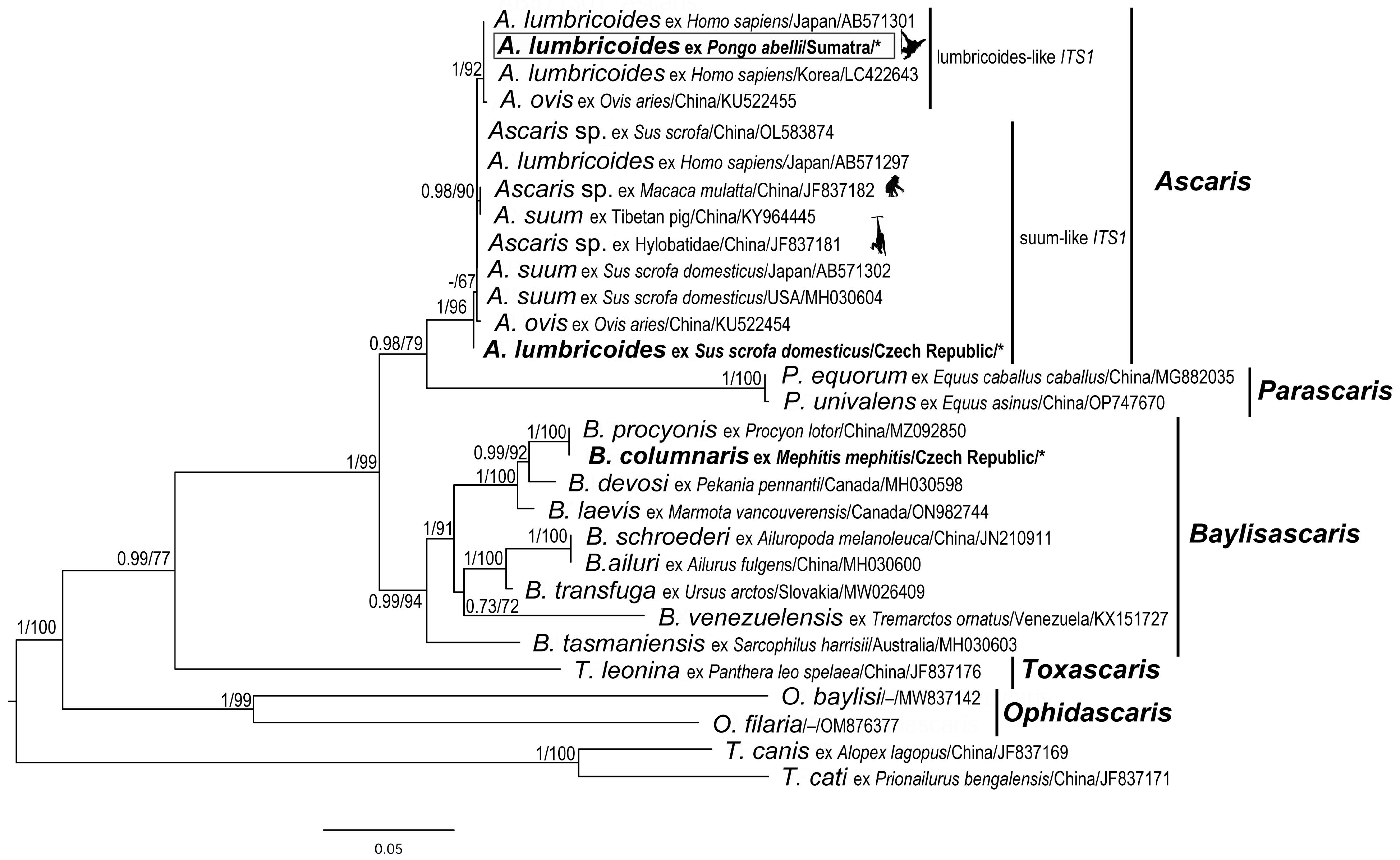
| Locus | Primer Name | Direction | Sequence (5′-3′) | PCR Fragment Size (bp) | Ta (°C) | Reference |
|---|---|---|---|---|---|---|
| 18S | 18S-F_P0 | Forward | CGCGAATRGCTCATTACAACAGC | >835 | 54 °C | [44] |
| 18S-R_P1 | Reverse | GGGCGGTATCTGATCGCC | ||||
| COI | CO1-F | Forward | TGGTTTTTTGTGCATCCTGAGGTTTA | 441 | 55 °C | [46] |
| CO1-R | Reverse | AGAAAGAACGTAATGAAAATGAGCAAC | ||||
| ITS1 | AscarisITSF1 | Forward | CGAGCAGAAAAAAAAAAGTCTCC | 558 | 55 °C | [45] |
| AscarisITSR1 | Reverse | GGAATGAACCCGATGGCGCAAT | ||||
| ITS2 | ITS2F | Forward | CGAGTATCGATGAAGAACGCAGC | 449 | 52 °C | [47] |
| ITS2R | Reverse | ATATGCTTAAGTTCAGCGGG | ||||
| ITS1-5.8S-ITS2 | TW81 | Forward | GTTTCCGTAGGTGAACCTGC | >870 | 54 °C | [42] |
| AB28 | Reverse | ATATGCTTAAGTTCAGCGGGT | ||||
| 18SNemF | Forward | TTGATTACGTCCCTGCCCTTT | >1080 | 55 °C | [43] | |
| 28SNemR | Reverse | GGAATCATTGCCGCTCACTTT |
| Name of CO1 Consensus/Haplotype Sequence | Host | Geographical Origin | GenBank Accession Numbers (Haplotype Identification) |
|---|---|---|---|
| A. lumbricoides/suum HapA1 (consensus) | Homo sapiens Linnaeus, 1758; Sus scrofa Linnaeus, 1758; Canis familiaris Linnaeus, 1758 | Italy, Uganda, Zanzibar (Tanzania), Banglades, Kenya, USA, Thailand, Myanmar, Brazil, China, Malaysia, Angola, Nepal | KC455934 (cavH12); EU582484 (betH1); KY200855 (US4); MF358911; MF358930; MH800233; MH800278-282; AJ968336; MK792803-809; MK143384-390 |
| A. lumbricoides/suum HapA2 (consensus) | H. sapiens; S. scrofa | Bangladesh, Uganda, Tanzania, Guatemala, Nepal, Thailand, Myanmar, Brazil | KF719095 (betH32); KF719112; KF719099; KF719099; KF719097; KF719096; MF358918 (sadH58); MF358909; MH800268; HM602025 |
| A. lumbricoides/suum HapA3 (consensus) | H. sapiens; S. scrofa | Slovakia, Italy, Hungary, China, Uganda, Great Britain, Denmark, Tanzania, Guatemala, Philippines, USA, Japan, Brazil, Thailand, Laos, Myanmar | KC455927 (cavH5); AJ968334; KF536870 (betH28); KF719120; KF719122; KF719129; KF719148; KY200852 (US1); JN575629; MF358933; MF358935; MF358922; MK143379; ON725083 |
| Ascaris sp. HapA4 (consensus) | H. sapiens; S. scrofa | Italy, Denmark, USA | KC455933 (cavH11); KF719139; KY200853 (US2) |
| A. lumbricoides/sp. HapA5 (consensus) | H. sapiens; S. scrofa | China, Japan | AJ968329; JN575630 |
| A. lumbricoides HapA6 (consensus) | H. sapiens; C. familiaris | Bangladesh, Tanzania, Thailand, Myanmar, Malaysia | EU582491 (betH8); MF358928; MF358932, MK792800; MK792810-11 |
| A. lumbricoides HapA7 (consensus) | H. sapiens | China, Laos, Thailand, Myanmar | AJ968333; MF358910; MF358912; MF358916 |
| A. lumbricoides HapA8 | H. sapiens | Thailand | MF358906 (sadH93) |
| A. lumbricoides HapA9 | H. sapiens | China | AJ968324 |
| A. lumbricoides (orangutan) | Pongo abelii Lesson, 1827 | Indonesia (Sumatra) | present study (LN600399) |
| A. ovis Hap1 | Ovis aries Linnaeus, 1758 | China | NC036666 |
| A. ovis Hap2 | O. aries | China | MT993838 |
| A. lumbricoides/suum HapB1 (consensus) | H. sapiens; S. scrofa | Italy, Zanzibar (Tanzania), Uganda, Denmark, Great Britain, Japan, USA, Brazil, China, Lithuania, Jordan, Netherlands, Slovakia, Thailand | KC455929 (cavH7); EU582490 (betH7); AB591796-98; AB591804-05; KY200854 (US3); MH674441-42; AJ968332; AJ968338; OL960110; KY368764; KY368763; KY368759; KY368756; JN575631; MW006083 |
| A. lumbricoides HapB2 (consensus) | H. sapiens | Zanzibar (Tanzania), Uganda, Guatemala, Brazil | EU582486 (betH3); MH800259; MH800275 |
| A. lumbricoides/suum HapB3 (consensus) | H. sapiens, S. scrofa | Zanzibar (Tanzania), China | EU582493 (betH10); AJ968340 |
| A. lumbricoides HapB4 (consensus) | H. sapiens | Brazil | GU326953; MH800220; MH800225; MH800229; MH800237; MH800252 |
| A. suum HapB5 | S. scrofa | China | AJ968337 |
| Ascaris sp. (gibbon) | Hoolock hoolock (Harlan, 1834) | China | KC839987 |
| Ascaris sp. (chimpanzee1) | Pan troglodytes (Blumenbach, 1775) | China | KC839986 |
| Ascaris sp. (chimpanzee2) | P. troglodytes | China | EU628687 |
| A. suum HapC1 (consensus) | S. scrofa | Tanzania, Uganda, Denmark, United Kingdom, Slovakia, Italy | KF719131-34 (betH64); KC455923 (cavH1); JN575632; KY045804 |
| Ascaris sp. HapC2 (consensus) | S. scrofa | Italy, Slovakia | KC455924 (cavH2); MZ008285 (NHap12) |
| Ascaris sp. HapC3 (consensus) | S. scrofa | Slovakia | KC455925 (cavH3); JN575633; MZ008286 (NHap13) |
| A. lumbricoides | S. scrofa | Czech Republic | present study (LN600400) |
| Baylisascaris ailuri | Ailurus fulgens F. Cuvier, 1825 | China | HQ671080 |
| B. columnaris | Mephitis mephitis (von Schreber, 1776) | Czech Republic | present study (LN600401) |
| B. devosi | Gulo gulo (Linnaeus, 1758) | Canada | KM216983 |
| B. laevis | Marmota vancouverensis Swarth, 1911 | Canada | ON982731 |
| B. procyonis | Procyon lotor (Linnaeus, 1758) | USA | MW385530 |
| B. schroederi | Ailuropoda melanoleuca (David, 1869) | China | HQ671081 |
| B. tasmaniensis | Sarcophilus harrisii (Boitard, 1841) | Australia | MH795156 |
| B. transfuga | Ursus maritimus Phipps, 1774 | China | HQ671079 |
| Ophidascaris baylisi | Python molurus bivittatus | China | MW880927 |
| O. filaria | Elaphe carinata | China | MH285588 |
| Parascaris equorum | Equus caballus Linnaeus, 1758 | China | MK209666 |
| P. univalens | Equus asinus Linnaeus, 1758 | China | MK209669 |
| Toxascaris leonina | C. familiaris | Australia | AJ920063 |
| Dimensions | Male Specimens | Female Specimens | ||||
|---|---|---|---|---|---|---|
| Host | H. sapiens | P. abelii | H. sapiens | P. abelii | ||
| No. of specimens | 2 | 3 | ||||
| Body length (cm) | 15.0–25.0 | 7.0–25.0 | 9.3–10.1 | 25–40 | 8–40 | 11.9–19.2 |
| Oesophagus length (mm) | 6.0–6.5 | 4–10 | 6.4–9.7 | 6.0–6.5 | 6–12 | 6.2–7.8 |
| Ratio oesophagus/body length (in %) | 4.0–2.6 | 8.6–4.0 | 9.7–7.0 | 2.4–1.63 | 7.5–3.0 | 6.52–4.42 |
| Tail length | - | 320–700 | 236–390 | - | 500–2000 | 700–978 |
| Ratio tail/body length (in %) | - | 4.6–2.8 | 3.9–2.5 | - | 6.3–5.0 | 5.5–5.0 |
| Number of precloacal papillae | 70 | 40–75 | 64–75 | - | - | - |
| Spiculae length | 2.0 | 930–2360 | 1065–1223 | - | - | - |
| Vulva distance (mm) | - | - | - | - | 30–135 | 42–65 |
| Ratio vulva distance/body length (in %) | - | - | - | - | 27.7–29.6 | 28.3–29.5 |
| References | [71] | [69] | Present study | [71] | [69] | Present study |
Disclaimer/Publisher’s Note: The statements, opinions and data contained in all publications are solely those of the individual author(s) and contributor(s) and not of MDPI and/or the editor(s). MDPI and/or the editor(s) disclaim responsibility for any injury to people or property resulting from any ideas, methods, instructions or products referred to in the content. |
© 2023 by the authors. Licensee MDPI, Basel, Switzerland. This article is an open access article distributed under the terms and conditions of the Creative Commons Attribution (CC BY) license (https://creativecommons.org/licenses/by/4.0/).
Share and Cite
Civáňová Křížová, K.; Seifertová, M.; Baruš, V.; Hodová, I.; Mašová, Š.; Nurcahyo, W.; Foitová, I. First Study of Ascaris lumbricoides from the Semiwild Population of the Sumatran Orangutan Pongo abelii in the Context of Morphological Description and Molecular Phylogeny. Life 2023, 13, 1016. https://doi.org/10.3390/life13041016
Civáňová Křížová K, Seifertová M, Baruš V, Hodová I, Mašová Š, Nurcahyo W, Foitová I. First Study of Ascaris lumbricoides from the Semiwild Population of the Sumatran Orangutan Pongo abelii in the Context of Morphological Description and Molecular Phylogeny. Life. 2023; 13(4):1016. https://doi.org/10.3390/life13041016
Chicago/Turabian StyleCiváňová Křížová, Kristína, Mária Seifertová, Vlastimil Baruš, Iveta Hodová, Šárka Mašová, Wisnu Nurcahyo, and Ivona Foitová. 2023. "First Study of Ascaris lumbricoides from the Semiwild Population of the Sumatran Orangutan Pongo abelii in the Context of Morphological Description and Molecular Phylogeny" Life 13, no. 4: 1016. https://doi.org/10.3390/life13041016
APA StyleCiváňová Křížová, K., Seifertová, M., Baruš, V., Hodová, I., Mašová, Š., Nurcahyo, W., & Foitová, I. (2023). First Study of Ascaris lumbricoides from the Semiwild Population of the Sumatran Orangutan Pongo abelii in the Context of Morphological Description and Molecular Phylogeny. Life, 13(4), 1016. https://doi.org/10.3390/life13041016





